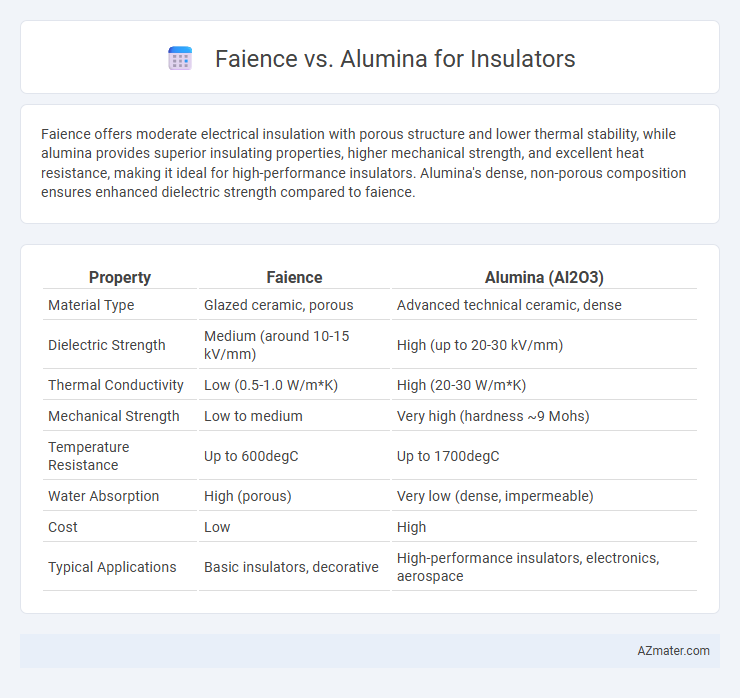Faience offers moderate electrical insulation with porous structure and lower thermal stability, while alumina provides superior insulating properties, higher mechanical strength, and excellent heat resistance, making it ideal for high-performance insulators. Alumina's dense, non-porous composition ensures enhanced dielectric strength compared to faience.
Table of Comparison
| Property | Faience | Alumina (Al2O3) |
|---|---|---|
| Material Type | Glazed ceramic, porous | Advanced technical ceramic, dense |
| Dielectric Strength | Medium (around 10-15 kV/mm) | High (up to 20-30 kV/mm) |
| Thermal Conductivity | Low (0.5-1.0 W/m*K) | High (20-30 W/m*K) |
| Mechanical Strength | Low to medium | Very high (hardness ~9 Mohs) |
| Temperature Resistance | Up to 600degC | Up to 1700degC |
| Water Absorption | High (porous) | Very low (dense, impermeable) |
| Cost | Low | High |
| Typical Applications | Basic insulators, decorative | High-performance insulators, electronics, aerospace |
Introduction: Understanding Electrical Insulators
Electrical insulators such as faience and alumina play crucial roles in preventing unwanted current flow in various applications, ensuring safety and device functionality. Faience, a glazed ceramic material, offers good insulating properties with moderate mechanical strength, commonly used in decorative and low-voltage applications. Alumina, a high-purity ceramic oxide, provides superior electrical insulation, exceptional thermal stability, and high mechanical strength, making it ideal for demanding industrial and high-voltage environments.
What is Faience? Composition and Properties
Faience is a glazed non-clay ceramic material primarily composed of silica, alkali, and various metal oxides, commonly used in electrical insulators due to its good dielectric strength and resistance to heat. Its properties include high electrical resistance, mechanical durability, and a smooth, glossy surface that provides protection against moisture and contaminants. Compared to alumina, faience offers adequate insulation performance but with lower thermal conductivity and mechanical strength.
What is Alumina? Composition and Properties
Alumina, or aluminum oxide (Al2O3), is a high-purity ceramic material widely used as an insulator due to its excellent electrical insulation, high thermal conductivity, and mechanical strength. Composed primarily of aluminum and oxygen atoms arranged in a crystalline hexagonal structure, alumina offers remarkable resistance to wear, corrosion, and high temperatures. These properties make alumina superior to faience, which is a glazed ceramic material with lower mechanical strength and thermal performance.
Manufacturing Processes: Faience vs Alumina Insulators
Faience insulators are manufactured using a glass-like ceramic process involving silica, alkali, and clay fused at relatively low temperatures, resulting in a porous, glazed surface that provides electrical insulation but limited mechanical strength. Alumina insulators undergo high-temperature sintering of purified aluminum oxide powder, producing a dense, crystalline structure with superior mechanical strength, thermal conductivity, and dielectric properties. The manufacturing process of alumina insulators involves precision shaping, high-pressure pressing, and controlled firing, yielding components highly suitable for demanding electrical insulation applications compared to the more traditional and less durable faience counterparts.
Mechanical Strength Comparison
Faience insulators exhibit lower mechanical strength compared to alumina insulators due to their porous ceramic composition, which makes them more susceptible to cracking under stress. Alumina insulators, composed of dense, high-purity aluminum oxide, provide superior compressive strength and resistance to mechanical impact, making them ideal for high-stress electrical applications. The higher fracture toughness and durability of alumina enhance its performance reliability in demanding environments where mechanical integrity is critical.
Electrical Performance and Dielectric Strength
Faience insulators, composed primarily of glazed ceramics, exhibit moderate electrical performance with dielectric strengths typically ranging from 10 to 15 kV/mm, suitable for low to medium voltage applications. Alumina insulators, made from high-purity aluminum oxide, offer superior dielectric strength often exceeding 20 kV/mm, and provide excellent electrical performance due to their low dielectric loss and high thermal conductivity. The enhanced dielectric properties and robustness of alumina make it a preferred material in high voltage and high reliability electrical insulation systems.
Durability and Longevity in Various Environments
Faience insulators offer moderate durability but are susceptible to environmental degradation such as moisture absorption and surface cracking, limiting their longevity in harsh, outdoor conditions. Alumina insulators exhibit superior mechanical strength, chemical resistance, and thermal stability, ensuring prolonged performance and reliability in diverse and extreme environments. Their enhanced resistance to wear and corrosion makes alumina the preferred choice for long-term applications in industrial and electrical insulation systems.
Cost-Efficiency and Economic Considerations
Faience insulators offer lower initial costs compared to alumina, making them economically viable for large-scale projects with budget constraints, while alumina insulators provide superior durability and higher thermal stability, reducing long-term maintenance expenses. The manufacturing process of alumina involves higher energy consumption and raw material costs, but its extended service life often offsets upfront price differences. Cost-efficiency analysis favors faience for short-term applications and alumina for investments prioritizing lifespan and performance in demanding environments.
Common Applications of Faience and Alumina Insulators
Faience insulators are commonly used in decorative electrical components, antique lighting, and low-voltage applications due to their aesthetic appeal and moderate insulating properties. Alumina insulators find extensive applications in high-voltage electrical systems, semiconductor manufacturing, and advanced electronic devices because of their superior thermal stability, mechanical strength, and excellent electrical insulation. Industries such as power transmission, aerospace, and medical equipment rely heavily on alumina insulators for critical performance under extreme conditions.
Choosing the Right Insulator: Faience or Alumina?
Faience insulators, known for their cost-effectiveness and adequate dielectric strength, are ideal for low to medium voltage applications requiring moderate mechanical strength. Alumina insulators, with superior thermal conductivity, higher mechanical robustness, and excellent electrical insulation properties, are preferred in high voltage and high temperature environments. Selecting between Faience and Alumina depends on application-specific requirements such as voltage level, thermal conditions, and mechanical stress tolerance to ensure optimal performance and longevity.

Infographic: Faience vs Alumina for Insulator
 azmater.com
azmater.com